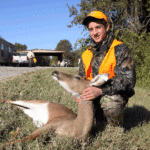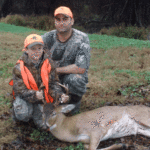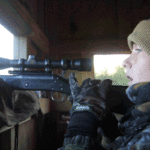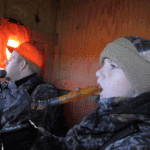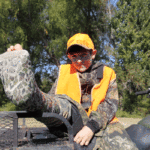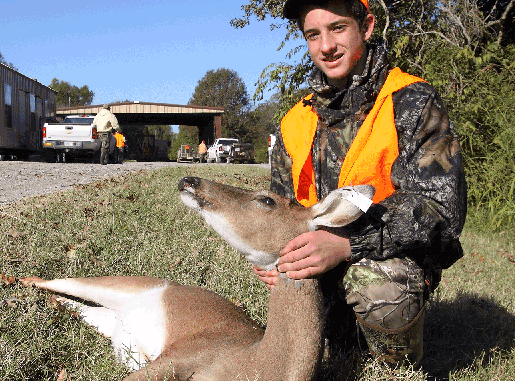
There’s no better way to hook a youngster on hunting than the Sherburne WMA youth deer hunts.
Following a short ATV ride before daylight, Jared Wolfe and his Uncle Joe Dunaway climbed into their assigned stand for the 2011 Sherburne WMA Youth Hunt.
Initially, the task took a bit of doing for the youngster, who had to overcome the nuisances of a cast he was wearing — courtesy of a foot injury incurred when jumping into too-shallow water.
The cast and growth plate doctors placed on top of his foot, though inconvenient, wasn’t enough to cause Wolfe to miss his lottery hunt on Sherburne. Settled in and checking out his confines the youngster was ready.
“All this stand needs is a television,” he said
For six seasons, the Louisiana Department of Wildlife & Fisheries have been holding youth lottery deer hunts on Sherburne Wildlife Management Area as part of a program to promote and provide opportunities for youth to hunt.
And, outside of the late-October weekend hunt, most of the youth hunts are scheduled during the Christmas and New Year Holidays, when kids out of school for a couple weeks can easily participate in perhaps a hunt of a lifetime.
Biologist manager and WMA Supervisor Tony Vidrine said that during the school break his staff works hard and long hours to ensure young hunters get opportunities to see and possibly harvest deer.
“Most of our hunts are during the week, and we schedule these hunts when kids are out of school,” Vidrine said. “We don’t want them to miss school, so we hunt five days a week while they’re out.
“We also work around youth lottery duck hunts we hold here. So, between our youth deer hunts and duck hunts, we’re out here everyday.”
Such long hours are worth it,however.
“There are some kids who come here who may never have been deer hunting or haven’t seen a whole bunch of deer or never had an opportunity to shoot a deer,” Vidrine said. “This gives them an opportunity to see and maybe take one.”
The sheer numbers of deer youth will see on the WMA is due to the way the LDWF manages the property.
“This area we basically don’t allow any gun hunting for deer,” Vidrine said. “You can bow hunt up to our first youth gun hunt in late October — from there on, no one can hunt the area at all.
“There’s a lot of deer here. There’s a real high concentration, and we want to keep it that way. You’ve got certain days they’ll come out here and five stands will see 100 deer. Other days they may not be moving, and they won’t see a whole lot.”
Long hours on the stand can move you from those intense, excited alert moments around daylight to the feeling of “chalking it up for the day” the closer to mid-morning you get.
Wolfe’s Uncle Joe made a great chaperone. Packed in Wolfe’s knapsack were snacks, binoculars and a grunt call. All of which Dunaway introduced by subtle suggestion as the sun moved overhead.
And though this was his first time hunting Sherburne, it wasn’t Wolfe’s first time hunting deer. Somewhat seasoned for such a young age, having killed a deer every year he has hunted, he knew instinctively how to use his binoculars to study the field’s edges, whispering to his uncle even the flicker of a bird’s wing when movement was caught.
“Do you think they’re still moving?” Wolfe whispered to his uncle around 9:30 a.m.
Hunting is about honesty, and sometimes it isn’t happening on the stand you’re in that day. And, even though the young hunter could hear shots other youth hunters obviously were making, he didn’t get discouraged.
Wolfe understood it simply meant the deer around his stand weren’t moving.
“He doesn’t see deer every time he goes,” Dunaway said. “He knows its part of hunting.”
Close to lunchtime, it was time to pull out all the stops: Wolfe broke out his grunt call to see if he could make something happen in an otherwise uneventful morning.
But, alas, it to had no impact on the outcome of Wolfe’s morning on the stand with his Uncle Joe.
Wolfe, knowing he still had the afternoon hunt summed the morning hunt up in two words.
“Maybe tonight,” he said.
Like most 11-year-olds, Wolfe stays active. Besides hunting he likes to fish, play football and soccer. The youngster said he doesn’t have too much time to play video games, but when he does he plays Cabelas Dangerous Hunts.
And, when asked what he wanted to do when he grew up, he precociously said, “Be on TV hunting!”
Back at the South Farm headquarters, where the hunts are held on the WMA, stories from the morning hunt were in abundance.
Ten-year-old Jacob Matthews anxiously sat in a box stand with his father Doug, waiting for deer to come out.
Suddenly, he spotted a young doe close to his stand, moving fast. Trying to hurry, Matthews missed.
Moments later, more deer walked out.
This time Matthews was ready. Squeezing off a round from his single shot .30-30, the youth hunter from Arnuadville missed again.
“The first time, a little one came out and I tried to hurry and missed,” Matthews recounted. “Then some more came out and stepped into the road. They heard something and looked right at the box stand we were in — then one of them went into the woods.
“I wasn’t nervous when I shot at the first one, but the second one I was.”
Ten-year-old Jeremy Sigler, another seasoned hunter who lives in Pineville, drew out not only for Sherburne WMA’s youth hunt, but Buckhorn WMA’s youth hunt.
On his weekend hunting Buckhorn, the youngster harvested three deer. At Sherburne, he was covered in deer again during his morning hunt, winding up harvesting a button buck.
“Me and my dad saw nine deer — most of them all bucks,” Sigler said. “There was one 9-point, and they were moving all around for a while. When the button buck stepped out, I shot it and then two bigger ones came out.”
Quality Deer Management Association’s South Louisiana Chapter provides lunch for the youngsters. Additionally, the Chapter has regularly supplied materials to build stands for the youth hunts on WMAs.
Jim Bondi, a wildlife technician on the WMA, said all of the stands are clean and comfortable.
“We don’t guide them, but we do take them out with their dads or whoever is going to sit with them,” Bondi said. “We’ll drop them off and give them a little direction and let them go.
“We’ll pick them up after their hunt, track their deer if necessary and bring their deer in, too.”
Wolfe and his Uncle Joe were the last to come in from the morning hunt and first out that afternoon.
“We ate our burgers and pretty much went back out to stay after them,” said Dunaway, an accomplished deer hunter in his own right. “But one of things we did in the afternoon was take our cammo jackets and shirts off and placed them over the window to provide more concealment — thinking the deer may see movement — and we made slits for Jared to shoot through.”
It wasn’t long before Dunaway’s suggestion was put to the test when a doe came out in the early afternoon.
The young hunter didn’t shoot that particular deer, and the rest of the afternoon became a waiting game.
It was about 30 minutes before sunset when things started to happen.
“We saw one doe early, and then after a while we didn’t see anything and it was real quiet,” Wolfe said. “After a while, just before sunset, I saw a button buck coming up over the hill down at the end of the food plot. My Uncle Joe said, ‘Don’t move; there’s another one coming.’
“She came out about 50 to 100 yards away. I couldn’t really move, because she was watching us.”
The nanny was definitely suspicious.
“She was real wary,” Dunaway said. “She’d take a nibble of grass and look at the blind, take a nibble of grass and look at the blind. The yearlings stayed in the soybeans and thick stuff. She came out, but was real leery of that box stand.”
Wolfe had a few problems positioning his rifle, ultimately shooting in an unorthodox manner.
“I had to put the gun on top of my shoulder like a rocket launcher, instead of in the shoulder, where it should be,” he explained. “I had to shoot like that. Well, I shot and the scope hit me in the eye, but she only went about 20 yards.
“She weighed 120 pounds and was a 4-year-old healthy deer.”
For the LDWF it’s all about the kids.
“I think if we give them the opportunity to see deer, then I think we’re doing what we’re supposed to be doing,” Vidrine said. If they get an opportunity to take one, then it’s a bonus.”
